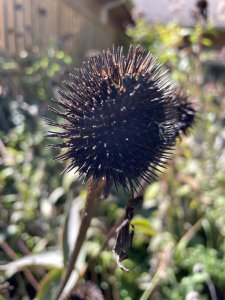Climate Stewardship in Your Garden: Seed collecting, fall planting, and winter sowing
October 25, 2023
Erin Parker, Interpretive Services Supervisor
Fall’s arrival signals different things to wildlife and people. Insect-eating birds head to southern climates, many mammals molt into a fresh coat of fur to get them through the winter, and humans get out to enjoy the change in season. While we may associate gardening with spring, autumn is an excellent time to think about adding indigenous plants to your landscape through seed collection, planting, and prepping for some mid-winter sowing projects.
Going to seed
As pollinating insects migrate or die with the onset of winter, flowering plants are shedding their petals and going to seed. Fall can be a great time to collect seeds from local plants that share our climate conditions and are well adapted to our region. Plants in your garden can be a great first source of those seeds because you already know how they do in your specific landscape conditions. Look for ripening seedheads and seedpods throughout the fall. Seeds should be fully formed and dry for harvest, which often means keeping close watch on drying pods and seedheads so that wind, precipitation, or animals don’t spread them before you’ve collected what you need.
A paper lunch sack can be tied around the flowerhead or seedpod to collect small seeds or for plants like milkweed where they are likely to fly away on a windy day. Shake out the seeds into the bag and leave the stalk and flowering parts behind to provide shelter for insects, birds, and other wildlife over the winter.
Tips and reminders:

- Only collect seeds from plants at locations where collecting isn’t prohibited
- Seeds are an important food source to get many species through the winter, make sure you’re only collecting seeds you can use
- Ask permission before doing collecting on public or private lands, being a good steward is also being a good neighbor
Fall planting
Autumn is also an excellent time to add native seeds and plants to your landscape. Cooler, wetter weather gives roots an opportunity to get settled in before winter, providing your best opportunity for successfully planting trees and shrubs.
Many native seeds require stratification, exposure to cold and moist conditions that mimic our winter soil temperatures, to germinate. There are a couple of ways to accomplish this- one is to store seeds in a cool space, such as a refrigerator until spring and then plant them after they’ve experienced winter-like conditions. The other way is to spread seeds in the fall, gently covering them with soil and leaf mulch, and letting them stratify in nature. Come spring, these seeds will germinate and grow.
This can be a less expensive way to increase native plants in a garden vs buying plants in the spring. While they may start out smaller, plants grown from seed overwintered in the garden will eventually catch up to their store-bought, larger cousins.
Winter Sowing
If autumn’s tasks get away from you, there’s another great way to get a head start on increasing your native plants in the spring. Take those seeds that you’ve collected (or purchased) and plant them in January!
Winter sowing is a great way to scratch a gardening itch in the depths of winter. Around the 1st of the year, collect some recyclable plastic containers (such as yogurt or cottage cheese tubs) and poke 4-6 holes in the bottom of each one for drainage. Fill them ¾ of the way with damp potting soil, thickly plant seeds, add additional potting soil just to cover, and then place all the containers outside. They don’t need lids, but do need to be out where they get exposed to rain, snow, and sun throughout the winter. They’ll get their cold stratification during the winter months, and sprout early in the spring. Plant them out in the spring or keep them watered and let them grow out during the summer, ready to put in the ground in the fall. Seeds planted this way can be planted thickly, to mimic more natural prairie conditions. Be sure to label each container!
